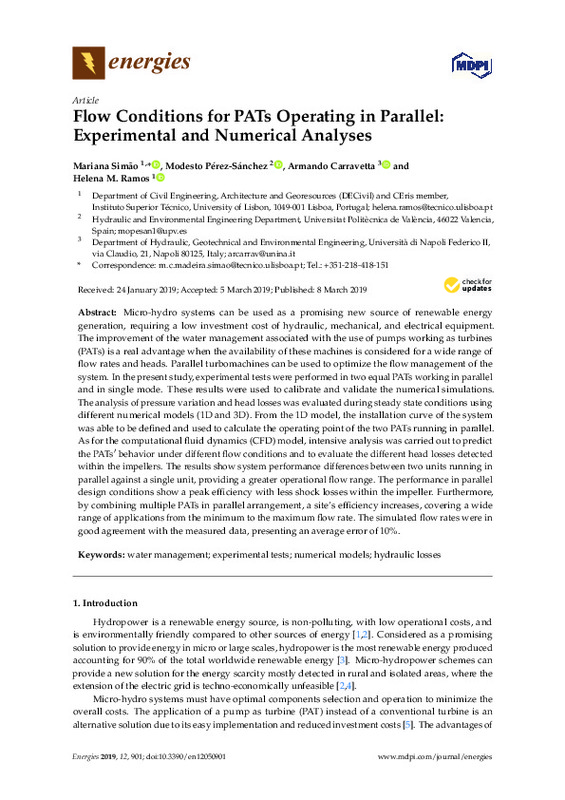JavaScript is disabled for your browser. Some features of this site may not work without it.
Buscar en RiuNet
Listar
Mi cuenta
Estadísticas
Ayuda RiuNet
Admin. UPV
Flow Conditions for PATs Operating in Parallel: Experimental and Numerical Analyses
Mostrar el registro sencillo del ítem
Ficheros en el ítem
| dc.contributor.author | Simao, M
|
es_ES |
| dc.contributor.author | Pérez-Sánchez, Modesto
|
es_ES |
| dc.contributor.author | Carraveta, Armando
|
es_ES |
| dc.contributor.author | Ramos, Helena M.
|
es_ES |
| dc.date.accessioned | 2019-04-03T20:02:14Z | |
| dc.date.available | 2019-04-03T20:02:14Z | |
| dc.date.issued | 2019 | es_ES |
| dc.identifier.uri | http://hdl.handle.net/10251/118939 | |
| dc.description.abstract | [EN] Micro-hydro systems can be used as a promising new source of renewable energy generation, requiring a low investment cost of hydraulic, mechanical, and electrical equipment. The improvement of the water management associated with the use of pumps working as turbines (PATs) is a real advantage when the availability of these machines is considered for a wide range of flow rates and heads. Parallel turbomachines can be used to optimize the flow management of the system. In the present study, experimental tests were performed in two equal PATs working in parallel and in single mode. These results were used to calibrate and validate the numerical simulations. The analysis of pressure variation and head losses was evaluated during steady state conditions using different numerical models (1D and 3D). From the 1D model, the installation curve of the system was able to be defined and used to calculate the operating point of the two PATs running in parallel. As for the computational fluid dynamics (CFD) model, intensive analysis was carried out to predict the PATs0 behavior under different flow conditions and to evaluate the different head losses detected within the impellers. The results show system performance differences between two units running in parallel against a single unit, providing a greater operational flow range. The performance in parallel design conditions show a peak efficiency with less shock losses within the impeller. Furthermore, by combining multiple PATs in parallel arrangement, a site¿s efficiency increases, covering a wide range of applications from the minimum to the maximum flow rate. The simulated flow rates were in good agreement with the measured data, presenting an average error of 10%. | es_ES |
| dc.description.sponsorship | This research was funded by project REDAWN (Reducing Energy Dependency in Atlantic Area Water Networks) EAPA_198/2016 from INTERREG ATLANTIC AREA PROGRAMME 2014-2020. | |
| dc.language | Inglés | es_ES |
| dc.publisher | MDPI AG | es_ES |
| dc.relation.ispartof | Energies | es_ES |
| dc.rights | Reconocimiento (by) | es_ES |
| dc.subject | Water management | es_ES |
| dc.subject | Experimental tests | es_ES |
| dc.subject | Numerical models | es_ES |
| dc.subject | Hydraulic losses | es_ES |
| dc.subject.classification | INGENIERIA HIDRAULICA | es_ES |
| dc.title | Flow Conditions for PATs Operating in Parallel: Experimental and Numerical Analyses | es_ES |
| dc.type | Artículo | es_ES |
| dc.identifier.doi | 10.3390/en12050901 | es_ES |
| dc.relation.projectID | info:eu-repo/grantAgreement/FEDER//ATLANTIC-EAPA_198/2016/EU/Reducing energy dependency in atlantic area water networks/REDAWN/ | es_ES |
| dc.rights.accessRights | Abierto | es_ES |
| dc.contributor.affiliation | Universitat Politècnica de València. Departamento de Ingeniería Hidráulica y Medio Ambiente - Departament d'Enginyeria Hidràulica i Medi Ambient | es_ES |
| dc.description.bibliographicCitation | Simao, M.; Pérez-Sánchez, M.; Carraveta, A.; Ramos, HM. (2019). Flow Conditions for PATs Operating in Parallel: Experimental and Numerical Analyses. Energies. 12(901):1-19. https://doi.org/10.3390/en12050901 | es_ES |
| dc.description.accrualMethod | S | es_ES |
| dc.relation.publisherversion | http://doi.org/10.3390/en12050901 | es_ES |
| dc.description.upvformatpinicio | 1 | es_ES |
| dc.description.upvformatpfin | 19 | es_ES |
| dc.type.version | info:eu-repo/semantics/publishedVersion | es_ES |
| dc.description.volume | 12 | es_ES |
| dc.description.issue | 901 | es_ES |
| dc.identifier.eissn | 1996-1073 | es_ES |
| dc.relation.pasarela | S\380292 | es_ES |
| dc.contributor.funder | European Regional Development Fund |








